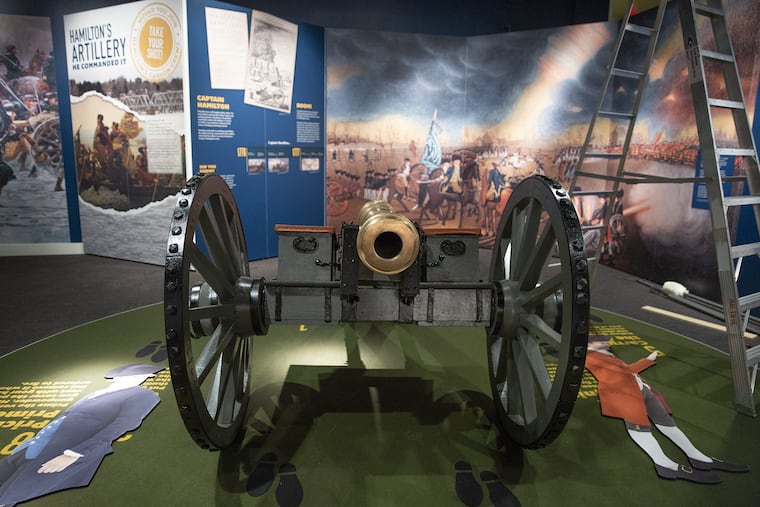Alexander Hamilton is the star of a new exhibit at the Museum of the American Revolution
"This exhibit makes the point that many of Hamilton's chief contributions and deepest challenges happened right here in Philadelphia. "

Young history buffs tired of sitting at home and singing along to the Hamilton soundtrack can find an interactive experience about the statesman and Founding Father at the Museum of the American Revolution. The new, family-friendly exhibit — "Hamilton Was Here: Rising Up in Revolutionary Philadelphia" — offers hands-on activities that let visitors grapple with some of the tough questions Alexander Hamilton faced during his momentous life, then point the way toward following in his footsteps at key Revolutionary sites in the city.
"Because of the musical, there's far more attention and notoriety being visited on Alexander Hamilton than there has been in generations," says Philip Mead, the museum's chief historian and director of curatorial affairs. "But the focus is on New York. This exhibit makes the point that many of Hamilton's chief contributions and deepest challenges happened right here in Philadelphia. More amazingly, the fabric of the city where all those things happened is still largely present, so we're encouraging people to go out and explore the Hamilton story in the museum that we live in."
Each section of "Hamilton Was Here" represents a different location that played a key role in Hamilton's development and has an accompanying challenge. Immediately upon entering, visitors are confronted by a full-size replica bronze cannon, showcasing the challenges of 18th-century warfare and the importance of teamwork as it explains how seven people were required to load and fire the weapon (and allows guests to play one of those roles).
From there, the story progresses to the first duel in which Hamilton was involved – predating his infamous final one by more than 25 years. In the showdown, he served as the second for fellow Continental Army officer John Laurens at a site in what is now Port Richmond (possibly now covered by a Target parking lot). The display asks visitors to imagine themselves in Hamilton's place as he supported a friend engaged in violent conflict.
"Throughout the museum," Mead says, "we try to put people in the positions and the predicaments of long ago. It's an exercise in empathy and a way of teaching people about more than history, but also about life lessons."
From there, visitors can literally weigh the issues being debated during the Constitutional Convention at Independence Hall by placing blocks representing state and federal powers on a huge scale. Hamilton's political career continues inside a replica of the President's House dining room (just blocks from the skeletal representation of the actual site), where he created the concept of presidential levees where citizens could meet with George Washington.
A collection of games helps young visitors envision the ideas devised by Hamilton as the first Secretary of the Treasury, including a Battleship-inspired board game pitting smugglers against the Revenue Marine cutter service (precursor to the Coast Guard) and a coin-designing opportunity that introduces the meanings and controversies behind the symbols represented on currency. The final piece discusses Hamilton's role in putting down the Whiskey Rebellion, introducing thorny questions of protest and military force against citizens.
Interactive throughout, "Hamilton Was Here" is an experience for children that Mead admits is an experiment for a history exhibit. "This is not the kind of learning that you typically get in history museums," Mead says, "where it's often didactic messages on the wall and objects in cases. Science museums do a much better job of teaching through doing, asking and answering questions through physical activity. We're trying to put that learning style in a history museum context."
Although geared toward a younger audience (and not to mention Broadway-inspired Hamilton fanatics), the exhibit doesn't shy away from tough questions and controversial subjects. Many of the moral dilemmas posed by Hamilton's life and the Revolutionary period deal with the compromises made by the Founding Fathers around slavery as well as the limited opportunities for women to be heard during the era. "This is not an exhibit that elevates and valorizes Hamilton," Mead says, "but an exhibit where you think through and question Hamilton and what he was about."
That's also something that Lin-Manuel Miranda manages to do in song form, which Mead praises the composer for and which he says should prepare visitors for the topics broached at the museum. "The Broadway show has built more enthusiasm for the Revolutionary period, particularly among young people, than any book or exhibit," he says. "It also raises a lot of complicated, important questions about the nation and what it means, which is also a big commitment for this museum. So this is a chance to intersect with the good that the musical is doing: to prompt people to ask questions about history and about the present."
SEE THIS
Hamilton Was Here: Rising UP in Revolutionary Philadelphia
Oct. 27-Mar. 17, Museum of the American Revolution, 101 S. Third St., 877-740-1776, AmRevMuseum.org